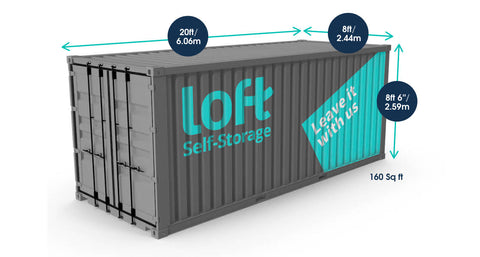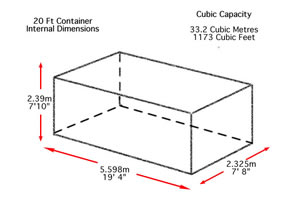This is Anthony Thompson, chief editor and the founder of this site, Tinyhousegarage. I'm a home architect. Basically, I've created this site to help people...Read more
How Many Square Feet Is A 20Ft Container?
Have you ever wondered about the size of a 20ft container? Well, you’ve come to the right place! Let’s dive into it and find out how many square feet a 20ft container has.
So, what’s the deal with 20ft containers? How much space do they actually offer? Stay tuned as we unravel this mystery and discover the answer together!
A 20ft container typically has an approximate floor area of 160 square feet. However, it’s important to note that this measurement may vary slightly depending on the specific dimensions of the container. The overall floor length of a standard 20ft container is 19’4″, with a floor width of 7’8″. So, if you multiply these two measurements together, you get an estimated floor area of around 150 square feet. Keep in mind that this is just an approximation and can vary based on the container’s design.
Key Takeaways
- A 20ft container has approximately 160 square feet of floor space.
- This is equivalent to about 14.86 square meters.
- The dimensions of a 20ft container are roughly 20 feet long, 8 feet wide, and 8.5 feet tall.
- These containers are commonly used for shipping goods and for storage purposes.
- They can be easily transported on trucks, trains, and ships.

How Many Square Feet Is A 20Ft Container?
If you’re in the shipping or logistics industry, or if you’re planning to transport goods internationally, you’ve likely come across the term “20ft container.” These containers are a standard size used for shipping and represent a significant portion of the global trade industry. One common question that arises is how many square feet a 20ft container encompasses. In this article, we’ll explore the dimensions and calculate the square footage of a 20ft container, as well as provide some additional information about its uses and benefits.
The Dimensions of a 20ft Container
Before we dive into calculating the square footage of a 20ft container, it’s essential to understand its dimensions. A 20ft container, also known as a 20-foot shipping container or a 20ft ISO container, has a length of 20 feet, a height of 8 feet 6 inches, and a width of 8 feet. These dimensions are based on the standard intermodal containers used in international shipping. It’s important to note that these measurements may vary slightly depending on the specific container manufacturer and any modifications made to the container.
The Calculation: Square Footage of a 20ft Container
To calculate the square footage of a rectangular object, we multiply its length by its width. Applying this formula to a 20ft container, we can determine its square footage. As mentioned earlier, a 20ft container has a length of 20 feet and a width of 8 feet. Multiplying these values together gives us a square footage of 160 square feet for the base area of the container. However, we must consider the height of the container as well to calculate the total square footage.
Since a 20ft container has a height of 8 feet 6 inches, or approximately 8.5 feet, we can multiply the base area by the height to obtain the total cubic footage of the container. Multiplying 160 square feet (base area) by 8.5 feet (height) gives us a total of 1,360 cubic feet. It’s important to remember that this calculation represents the internal volume of the container and not the external dimensions. Additionally, the actual usable space within the container may be slightly less due to the container walls and corner fittings.
Other Important Considerations
While knowing the square footage of a 20ft container is valuable, there are other factors you should consider when utilizing this type of container. Here are a few additional points to keep in mind:
- Cargo restrictions: Different types of cargo have specific weight restrictions, and it’s important to consult the appropriate guidelines to ensure your goods comply with international shipping regulations.
- Packing configuration: The actual usable space within a 20ft container may vary depending on how you pack your goods. Proper packing techniques, such as utilizing pallets or stacking items efficiently, can maximize the available space.
- Additional storage: 20ft containers are not limited to shipping and transportation. They are also commonly used for storage purposes. If you need extra space on-site, a 20ft container can provide a secure and convenient solution. Make sure to consider any local regulations or permits required for storing containers on your property.
Benefits of Using a 20ft Container
Now that we have explored the dimensions and square footage of a 20ft container, let’s take a look at some of the benefits it offers:
1. Versatility:
A 20ft container can be easily transported by various modes of transportation, such as ships, trains, and trucks. Its standardized dimensions ensure compatibility with most shipping methods, making it a versatile option for moving goods across different routes and networks.
2. Cost-effectiveness:
Compared to larger containers such as 40ft or 45ft containers, a 20ft container is more cost-effective. It requires less space during transportation and can fit into tighter spaces, resulting in potentially lower shipping costs.
3. Easy handling and storage:
Due to its manageable size, a 20ft container is easier to handle, load, and unload than larger containers. It can be maneuvered into tighter spaces, making it convenient for transportation and storage purposes.
4. Modular expansion:
Another advantage of using 20ft containers is their modular nature. They can be easily stacked or joined together to create larger storage or workspace areas. This flexibility makes them an ideal choice for temporary structures, such as pop-up shops or construction site offices.
Key Points to Remember
– A 20ft container has a length of 20 feet, a height of 8 feet 6 inches, and a width of 8 feet.
– The base area of a 20ft container is 160 square feet, and the total cubic footage is 1,360 cubic feet.
– Consider cargo restrictions, packing configuration, and additional storage options when utilizing a 20ft container.
– The benefits of using a 20ft container include versatility, cost-effectiveness, easy handling, and modular expansion capabilities.

Frequently Asked Questions
Below are some common questions people have about the square footage of a 20ft container.
1. How much square footage does a 20ft container have?
A 20ft container typically has around 160 square feet of floor space. This is calculated by multiplying the container’s length (20ft) by its width (8ft).
This square footage can be used as a rough estimate for planning purposes when considering the storage or transportation capacity of a 20ft container.
2. Can I modify the square footage of a 20ft container?
The square footage of a 20ft container is determined by its physical dimensions and cannot be easily modified. However, you can maximize the usable space by utilizing smart storage solutions such as shelves or racks.
Efficiently organizing the contents of the container can help make the most of the available square footage and ensure optimal utilization of the space.
3. Is the square footage the same for all 20ft containers?
Yes, the square footage is generally the same for all standard 20ft containers. The difference in dimensions usually comes in the height of the container, which can vary.
However, it’s worth noting that some specialized containers, such as high cube containers, have increased height, which can slightly impact the square footage. It’s always a good idea to verify the specific dimensions of the container you are working with.
4. How does the square footage of a 20ft container compare to other container sizes?
The square footage of a 20ft container is smaller compared to larger container sizes. For example, a 40ft container has approximately 320 square feet of floor space, double the square footage of a 20ft container.
When determining the right container size for your needs, it’s important to evaluate the amount of space required for the intended purpose, taking into consideration the size of the items to be stored or transported.
5. Can I convert the square footage to cubic footage?
No, square footage and cubic footage are two different measurements. Square footage refers to the area of the container’s floor, while cubic footage measures the total volume of the container (length x width x height).
If you need to calculate the cubic footage of a 20ft container, you would also need to know the height of the container. Multiplying the square footage by the height will give you the cubic footage of the container.
What’s the difference between a 20ft Container and 40ft Container?
Summary
A 20-foot container measures 20 feet long, 8 feet wide, and 8.5 feet high. When calculating the square footage, we multiply the length by the width, which gives us 160 square feet. However, keep in mind that the usable space may be less due to the container’s structural elements.
Additionally, it’s important to consider the internal dimensions of the container when determining its square footage. These dimensions can vary depending on the design and construction of the container, so it’s always advisable to check with the manufacturer or seller for accurate measurements.
To summarize, a 20-foot container has a square footage of around 160 square feet, but the usable space may be slightly smaller due to structural elements and the internal dimensions may vary.

This is Anthony Thompson, chief editor and the founder of this site, Tinyhousegarage. I'm a home architect. Basically, I've created this site to help people build tiny houses with a limited budget and land space or people who are homeless. As a home architect, I became very disheartened when I saw homeless people around me, which influenced me to create this site to help people build beautiful tiny houses.
More Posts
